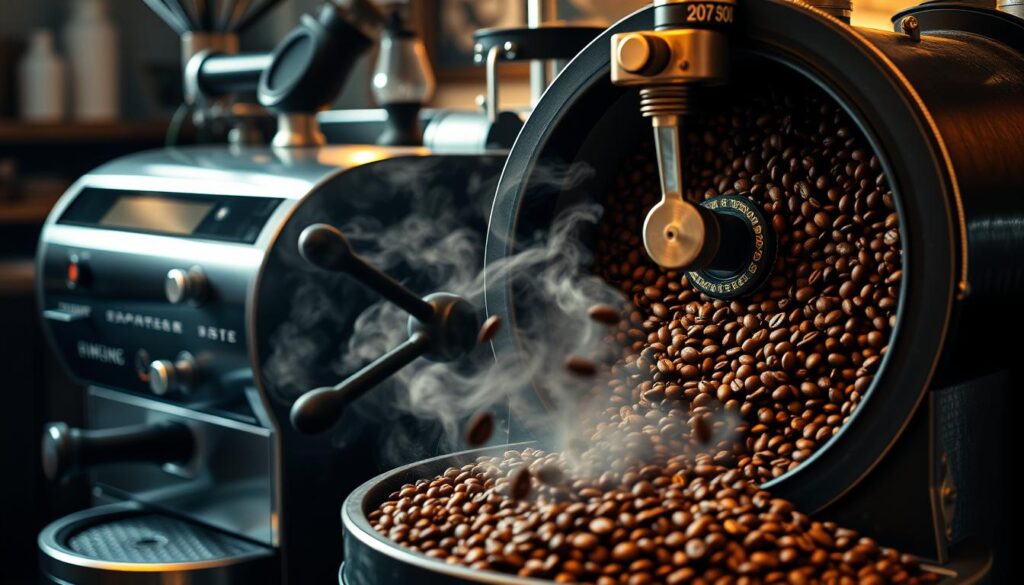Ever thought about if espresso is less acidic than regular coffee? The truth is, coffee’s acidity can change a lot. It depends on how it’s roasted and brewed. We’ll explore the details that show if espresso is really less acidic.
Key Takeaways
- The typical pH value of coffee ranges between 4.85-5.10, with lower numbers indicating higher acidity.
- Roasting methods, bean origin, and brewing techniques can all impact the acidity levels in coffee and espresso.
- Traditional dark roast espresso was often less acidic, but modern roasting techniques have led to more acidic espresso varieties.
- Factors like elevation, coffee bean type, and brewing method can significantly influence the final acidity of the coffee or espresso.
- Individuals with acid-related medical conditions may benefit from choosing low acid coffee options, such as slow-roasted espresso or darker roasts.
Coffee Acidity Basics
Acidity in coffee is complex and important for flavor. The coffee pH level is affected by many things. These include the coffee bean’s origin, where it’s grown, how it’s roasted, and how it’s brewed.
What Determines Coffee’s pH Levels
The pH scale measures coffee’s acidity measurement from 0 to 14. Most specialty coffees have a pH of 4.85 to 5.10. This slight acidity adds brightness and vibrancy to the coffee, which many love.
The Role of Natural Acids in Coffee
The natural coffee acids like chlorogenic, quinic, and citric acids are key to coffee’s taste. These acids are in both green and roasted coffee. They’re influenced by where the coffee is grown, the type of coffee bean, and how it’s processed.
For example, coffee grown at high altitudes in cool climates tends to be more acidic. This is different from coffee grown at lower altitudes in warmer places.
Measuring Coffee Acidity
Measuring coffee acidity is vital for understanding its taste. Things like grind size, roast level, and water temperature affect how acidic the coffee tastes. By knowing these factors, coffee lovers and experts can adjust their brewing to get the perfect coffee pH and acidity measurement.
“Acidity in coffee is not necessarily a negative attribute and can contribute to desirable flavor characteristics such as brightness and vibrancy.”
Traditional vs Modern Espresso Roasting Methods
The world of espresso roasting has changed a lot over time. In the past, espresso was roasted dark, which made it bold and less acidic. But, the “third wave” coffee movement brought a new way to roast espresso.
Classic Dark Roast Techniques
Old-school espresso roasting went for a dark roast. This method used longer roasting times and higher temperatures. It made the coffee’s sugars caramelize, creating a rich, bold espresso with low acidity. This approach aimed to make a balanced, smooth espresso.
Third Wave Light Roasting Impact
Now, “third wave” espresso roasters prefer lighter roasts. These lighter roasts keep more of the coffee’s natural acidity. This makes the espresso brighter, more vibrant, and complex. It often has flavors of fruit, citrus, or tea.
Temperature and Duration Effects
The roasting temperature and time greatly affect espresso’s acidity. Longer roasts and higher temperatures lower acidity. Shorter roasts and lower temperatures keep more natural acids. This change has led to many different espresso flavors, pleasing many coffee lovers.

Is espresso less acidic than coffee
The question of whether espresso is less acidic than regular coffee is complex. Traditionally, espresso was less acidic because of darker roasts. But, modern roasting methods have changed this.
Several factors affect espresso’s acidity, like roast level, brewing method, and coffee bean origin. For example, light roasts have higher acidity than dark roasts. Also, cold brew coffee is less acidic than both traditional coffee and espresso.
The concentrated nature of espresso and its quick brewing process can also affect how we perceive its acidity. The strong flavor of espresso might make its acidity seem less noticeable than in regular coffee.
“Acidity in coffee is one of the basic taste characteristics that include body, aroma, sweetness, bitterness, and aftertaste.”
Research shows that low-acid coffee or espresso might have health benefits. These include reducing cancer risk, improving brain function, and lowering heart disease risk. But, how coffee affects health varies by person.
In conclusion, the acidity of espresso versus regular coffee depends on many factors. These include roasting method, bean origin, and brewing technique. Trying different brewing methods and coffee origins can help you find your ideal acidity level.
The Science Behind Espresso Extraction
The espresso extraction process is a delicate dance. It involves many factors that affect the acidity and flavor of the final shot. Knowing these details can help you make the perfect espresso.
Grinding Impact on Acidity
The size and consistency of your coffee grind matter a lot. A finer grind means more surface area. This leads to better extraction of acids, making the espresso more acidic.
A coarser grind, on the other hand, results in less acidic espresso. This is because the water has less contact with the coffee.
Pressure and Temperature Influence
Pressure and temperature also play a role in the acidity of your espresso. The best water temperature for extraction is between 195°F and 205°F (90°C to 96°C). This range helps dissolve acids and other compounds well.
The brewing pressure of 9 bars is also key. It forces water through the coffee grounds efficiently. This affects the extraction of acids.
Extraction Time Considerations
The length of the extraction process is important too. Shorter times, around 20 to 30 seconds, make the espresso more acidic. This is because some compounds are not fully extracted.
Longer times can make the espresso less acidic. This is because more acids are released and balanced by other flavors.
The combination of espresso extraction, coffee grinding, brewing pressure, and extraction time shapes your espresso’s acidity and flavor. By mastering these variables, you can create the perfect cup for your taste.

Health Implications of Coffee Acidity
Coffee can be a fun and energizing drink, but its acidity affects people differently. The pH scale shows coffee is usually acidic, with a pH between 4.85 and 5.10.
People with acid reflux, stomach ulcers, or irritable bowel syndrome (IBS) might find coffee’s acidity makes their symptoms worse. Even though coffee doesn’t cause these issues, it can make them feel more uncomfortable. You can make your coffee less acidic by choosing dark roasts, cold brewing, or adding milk. These methods can help balance out the acidity.
“The acidity in coffee can be a concern for individuals with certain health conditions, but there are steps you can take to enjoy your coffee while managing the possible impacts.”
It’s also important to think about coffee’s overall health effects. Some studies show it might help prevent type 2 diabetes or aid in weight loss. But, how coffee affects you can depend on many factors. Finding the right balance is key.
- Choose dark roast or cold-brewed coffee, which tend to be less acidic.
- Add milk or cream to help neutralize the acidity.
- Experiment with brew time and grind size to find the optimal acidity level.
- Consult with a healthcare professional if you have concerns about the impact of coffee acidity on your health.
Conclusion
The acidity of espresso versus regular coffee depends on many things. These include roasting methods, brewing techniques, and the type of coffee beans used. Modern roasting has made both espresso and regular coffee come in a wide range of acidity levels.
Knowing these factors helps coffee lovers make better choices. They can pick what they like based on taste and health. Trying different roasts, brewing methods, and additives can help find the perfect balance of flavor and acidity.
Exploring the science behind making espresso can also help. It involves understanding grinding, pressure, temperature, and how long it’s brewed. This way, coffee fans can get the taste they want, whether it’s a smooth espresso or a bold coffee.
In the end, whether to choose espresso or regular coffee is up to each person. By knowing what affects acidity, coffee drinkers can choose what suits their taste and health best. This ensures a great coffee experience every time.







